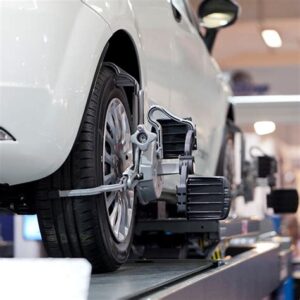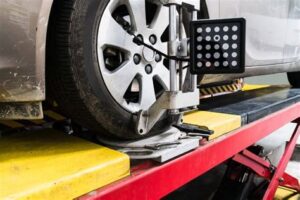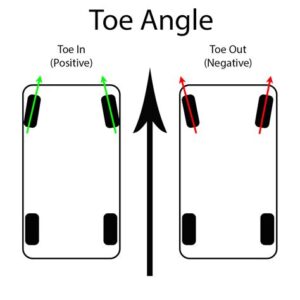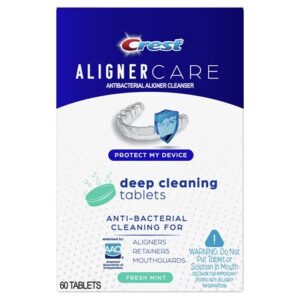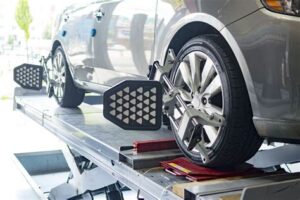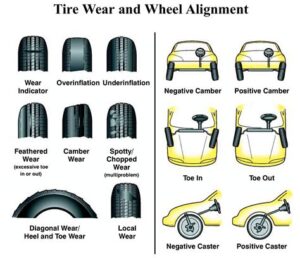Is your car veering to the left even after a recent alignment? You’re not alone, and this issue can be both frustrating and concerning for drivers. Understanding why your vehicle may pull to one side is crucial for ensuring safety and optimal performance on the road. In this article, we’ll explore common causes of car pulling after alignment, including the effects of tire pressure and suspension problems. We’ll also provide actionable steps to diagnose and fix these issues, along with maintenance tips to prevent future occurrences. Whether you’re a seasoned car enthusiast or just looking to maintain your vehicle’s integrity, our comprehensive guide will help you navigate this common dilemma effectively. Let’s dive in and reclaim a smooth, straight driving experience!
Common Causes Of Car Pulling After Alignment
When you notice your car pulling to the left even after alignment, several factors could be at play. Understanding these car pulling issues is critical for ensuring a safe and comfortable driving experience.
- Uneven Tire Wear: Tires that have worn unevenly can lead to car pulling. When one tire is more worn than the others, it can cause the vehicle to drift to one side.
- Tire Misalignment: In some cases, despite a recent alignment, tires might not be adjusted correctly, causing persistent car pulling. This can happen due to a technician’s error or if your vehicle has recently encountered a hard bump or curb.
- Braking System Issues: If a brake caliper is sticking or not functioning properly, it can cause the vehicle to pull to one side during braking. This is crucial to check, as it directly affects driving safety.
- Suspension Problems: Worn-out suspension components such as bushings, struts, or shocks can impact your vehicle’s alignment and handling, leading to car pulling.
- Tire Pressure Imbalance: If one tire has significantly lower or higher pressure than the others, this can cause the car to pull in that direction. Maintaining proper tire pressure is essential to prevent this issue.
Regular maintenance and inspections of your vehicle can help identify these potential problems before they lead to significant handling issues. Pay attention to any signs of car pulling and address the underlying causes promptly to ensure your safety on the road.
Effects Of Tire Pressure On Car Pulling
One of the critical factors that can contribute to car pulling is improper tire pressure. Tires that are overinflated or underinflated can significantly affect your vehicle’s handling and alignment. Here’s how tire pressure influences car pulling:
- Underinflation: When tires are underinflated, they create more rolling resistance on one side, leading to an uneven distribution of force that may cause the vehicle to drift or pull in one direction. This can make it feel as if the steering is being tugged, especially at higher speeds.
- Overinflation: Conversely, overinflated tires can lead to reduced contact with the road surface, which can also result in a car pulling to one side. The center of the tire may wear out more quickly, affecting traction and stability.
- Uneven Tire Pressure: If tire pressure varies from one tire to another, this discrepancy can cause the vehicle to pull in the direction of the tire with lower pressure. For example, if the left tire is underinflated compared to the right tire, you may experience a notable pull to the left.
- Impact on Alignment: Maintaining the correct tire pressure not only helps with preventing car pulling, but also supports your vehicle’s overall alignment. Consistent pressure across all tires ensures even tire wear and contributes to the longevity of your suspension components.
Regularly checking and adjusting your tire pressure according to the manufacturer’s specifications can significantly mitigate the risks of car pulling, ensuring safer and more comfortable driving.
How Suspension Issues Contribute To Car Pulling
Suspension issues are a significant factor when it comes to car pulling. An improperly functioning suspension system can lead to uneven weight distribution, causing the vehicle to veer to one side. Here are some common suspension-related problems that can contribute to this issue:
- Worn Out Shock Absorbers: Shock absorbers are designed to dampen the impact of road irregularities. When they wear out, it can cause instability, leading to increased car pulling.
- Misaligned Suspension Components: Components like control arms and bushings can become misaligned due to wear or accidents, leading to inconsistent handling and car pulling.
- Broken Springs: Springs are critical for maintaining ride height and balance. A broken spring can cause one side of the vehicle to sag, exacerbating car pulling.
Additionally, if the suspension is not level, it may result in uneven tire wear, which can further contribute to the car pulling issue. Regular inspections and maintenance of the suspension system are essential to ensure safe and comfortable driving. If you notice persistent pulling to one side despite a proper wheel alignment, it may be time to have your suspension system professionally examined.
Steps To Diagnose And Fix Car Pulling Issues
Diagnosing and fixing car pulling issues can be a straightforward process if approached methodically. Here’s a step-by-step guide to help you identify the cause and implement the necessary fixes.
| Step | Description |
|---|---|
| 1 | Check Tire Pressure: Begin by checking the tire pressure of all four tires. Inconsistent tire pressure can lead to car pulling. Inflate or deflate tires as needed to match the manufacturer’s specifications. |
| 2 | Inspect Tire Wear: Examine the tires for uneven wear patterns. If the tread is worn unevenly, it could be a sign of misalignment or improper inflation. |
| 3 | Alignment Check: Confirm that your recent alignment was done correctly. Misalignment is a common cause of car pulling, so if you suspect an error, consider having it re-evaluated. |
| 4 | Inspect Suspension Components: Check for any damaged or worn suspension parts such as struts, shocks, and control arms. Any defects in these components can contribute to car pulling. |
| 5 | Brake System Check: Ensure that your brake system is functioning properly. A sticking brake caliper or uneven brake pads can cause the car to pull to one side. |
| 6 | Balance the Wheels: If the tires are unbalanced, it can lead to pulling as well. Have your wheels balanced to improve overall handling. |
| 7 | Test Drive: After making any adjustments, take your vehicle for a test drive. Monitor if the car pulling persists. If it does, further investigation may be necessary. |
By systematically following these steps, you can effectively identify the cause of your car pulling issues and implement the necessary fixes to ensure safe driving. Remember, if you’re unsure at any point, it’s best to consult with a professional mechanic.
Preventing Car Pulling: Maintenance Tips And Tricks
To minimize the risk of car pulling and ensure a smooth driving experience, regular maintenance is essential. Here are some effective tips and tricks to help you prevent your vehicle from pulling to one side:
- Regular Wheel Alignment: Schedule wheel alignments at recommended intervals or whenever you feel the steering is off. This is crucial for maintaining proper tire alignment and preventing car pulling.
- Tire Rotation: Rotate tires every 5,000 to 8,000 miles. This promotes even wear and can help mitigate any pull caused by uneven tire wear.
- Monitor Tire Pressure: Check tire pressure monthly and keep them inflated to the manufacturer’s specifications. Incorrect tire pressure can significantly contribute to car pulling.
- Inspect Suspension Components: Regularly check the suspension system, including struts, shocks, and bushings, for any signs of wear or damage. Addressing suspension issues promptly can prevent car pulling.
- Check for Uneven Tire Wear: Be vigilant about inspecting your tires for uneven wear patterns. If detected, consult a professional to re-evaluate alignment and other related issues.
- Avoid Potholes and Road Hazards: Steer clear of potholes, curbs, and other road hazards that can misalign wheels or damage suspension parts.
- Maintain a Clean Underbody: Keep the underbody of your vehicle clean to prevent the buildup of dirt and debris that could impact the suspension or alignment.
By following these maintenance tips and being proactive about your vehicle’s health, you can significantly reduce the chances of experiencing car pulling issues. Keeping your car in optimum condition will not only enhance safety but also improve overall driving comfort.
Frequently Asked Questions
What does it mean when a car pulls to the left after an alignment?
When a car pulls to the left after an alignment, it indicates that there may be an issue with the alignment settings, tire pressure, or even underlying suspension components that need attention.
Why is it important to have a proper wheel alignment?
Proper wheel alignment is crucial for even tire wear, improved fuel efficiency, and overall vehicle handling. Misalignment can cause the car to pull to one side, making it harder to drive straight.
What are common causes for a car to pull to the left after an alignment?
Common causes include uneven tire pressure, worn suspension parts, or improper alignment angles that were not calibrated correctly during the service.
How can I check if my tire pressure is affecting alignment?
You can check tire pressure using a tire pressure gauge. Compare the readings to the recommended pressure levels specified in your vehicle’s owner’s manual or on the driver’s side door jamb.
Is it safe to drive a car that pulls to the left after an alignment?
It is not recommended to drive a car that consistently pulls to the left, as it can affect steering control and may lead to further vehicle damage. It’s best to have it inspected by a professional.
What should I do if my car continues to pull to the left after an alignment?
If your car continues to pull to the left after an alignment, you should take it back to the mechanic to investigate potential causes such as tire wear, suspension issues, or recalibrating the alignment.
How often should I have my car’s alignment checked?
It is advisable to have your car’s alignment checked at least once a year or whenever you notice uneven tire wear or experience steering issues, especially after hitting a pothole or curb.
